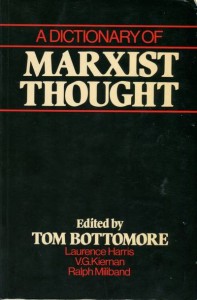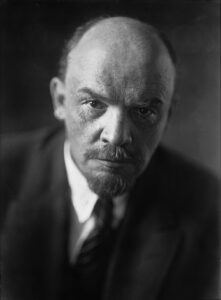Source: Bottomore, Tom. “Finance Capital.” A Dictionary of Marxist Thought, Basil Blackwell, Oxford, 1985, pp. 172–177.
The following text is presented under the terms of Fair Use.
finance capital The only form of capital that was not theorized by Marx but has become established as a valid category for twentieth-century Marxist theory. It is a form quite distinct from others such as financial, interest-bearing, or money capital. In the concept first promulgated by Hilferding (1910) it has two central characteristics: first, it is formed by the close integration of financial capital in the hands of banks, with industrial capital; and second, it arises only at a definite stage of capitalism. The existence of finance capital, thought Hilferding, has major implications for capitalism, being seen as integral to the development of monopolies (see CENTRALIZATION AND CONCENTRATION OF CAPITAL), to IMPERIALISM, and to the prospects for the overthrow of capitalism. It was these dynamic aspects which gave finance capital a significant place in the writings of Lenin and Bukharin, and have ensured that the debate over it has persisted to the present. Its significance for the application of Marxist theory to twentieth-century conditions was, indeed, implied by Kautsky and Bauer in their reception of Hilferding’s book, Finance Capital, as the completion of Marx’s preliminary ideas on the stage of capitalism that was only just emerging before his death. (See Bottomore 1981 and Coakley 1982 for the connections between Hilferding’s work and that of his contemporaries.)
The integration of financial and industrial capital, in a general sense, is not specific to finance capital. Throughout capitalism the existence of specialized financial capitalists holding, exchanging, borrowing, and lending money is possible only because of their articulation with the productive sectors; it is only by lending money to industrial capitalists that they can appropriate surplus value through interest, and only by operating the payments and foreign exchange systems for the transactions of the whole economy that they can appropriate surplus value through profit (see FINANCIAL CAPITAL AND INTEREST). However, it is the specific manner in which the two types of capital are integrated that distinguishes finance capital, and the essence of it is that the relationship ceases to be at arm’s length; as Hilferding wrote, finance capital arose from the forces that ‘bring bank and industrial capital into an ever more intimate relationship’ (emphasis added). Moreover, it is an intimacy in which the banks are the dominant partners, controlling industry and forcing change upon it.
Hilferding and Lenin, with different emphasis, identified three channels through which the banks’ control of industry is exerted. First, the rise of the JOINT-STOCK COMPANY enabled banks to take controlling shareholdings in industrial firms, and this facilitated not only control but a merging of identities so that ‘banks … become to a greater and greater extent industrial capitalists’. (Hilferding 1910, p. 225). Second, the ‘personal link-up’ (Lenin 1916, p. 221) achieved through the appointment of bank directors to the boards of industrial firms and vice versa, and the fact that the same persons who hold major shareholdings in banks hold them in industry too. Finally, the banks obtain detailed knowledge of ‘their’ industrial firms’ affairs by the fact that they handle their financial transactions; they know the state of their bank balance day by day and they handle the credit (bills of exchange) generated in the course of the firms’ everyday business. It is significant that the concept of finance capital was not developed with respect to financial capital in general dominating industrial capital; the channels of control were those by which a particular institutional form of the former, banks, interlocked with and dominated an institutional embodiment of the latter, joint-stock companies. Indeed, the framework was even more specific, for although they referred to other countries, Hilferding and Lenin did base their ideas primarily upon their observation of the system that dominated industrial Central Europe where the ‘universal bank’ was typical. Whereas commercial banks in the United Kingdom have historically concentrated on handling payments and giving short-term credits to industry, taking the view that industrialists know more about industry than bankers, the German universal bank has combined such functions with holding shares, floating share issues and holding directorships in industry.
The idea of an articulation between banks and industrial firms with the former dominating is, as such, static, but the essence of the idea of finance capital is that it is typical of a stage in the history of capitalism, and therefore both the product of historical forces and the generator of forces which would themselves transform the world. For Lenin (1916) finance capital was not itself a stage of capitalism but was, instead, an intrinsically prominent feature of the stage called monopoly capitalism or imperialism (see PERIODIZATION OF CAPITALISM). Monopoly capitalism was the stage in which competition between many capitals came to take the form of domination of whole industries by a handful of giant enterprises, trusts or cartels, but finance capital was an essential characteristic of it. Finance capital was not the interlocking of any bank with any firm but ‘the bank capital of a few very big monopolist banks, merged with the capital of the monopolist associations of industrialists’ (Lenin 1916, p. 266). The picture was one of giant trusts dominated by bankers and , wielding enormous power. In the hands \ of non-Marxists a similar picture informed populist and even fascist attacks on ‘the power of finance’ in the first half of this century, but Hilferding, Lenin and Bukharin saw their task as uncovering the laws that governed finance capital’s rise and its future. Finance capital was generated by the operation of two phenomena that Marx had identified. Concentration and centralization had created monopolistic firms in industry, while the rise of a modem credit system had concentrated into the hands of banks the savings of the whole community; the merging of the two was the outcome of monopolistic firms having nowhere else to go for the large blocks of finance needed to facilitate their accumulation, while the banks had no profitable alternative to investing their large inflows of funds in industry. Moreover, the merger in the form of finance capital was itself an impetus to the development of further monopolies as blocks of financial-industrial capital attempted to gain further control over the anarchy of their markets. In this process the promotion of new industrial enterprises by banks was an important strategy which generated a special form of profits, promoter’s profits, through the promotion itself.
The creation of monopolies, which both underlay and was given added impetus by finance capital, was seen by Lenin as inseparable from the internationalization of capital in imperialism. In his introduction to Bukharin’s Imperialism and the World Economy (1917) he explained the growth of finance capital by arguing that at
a certain stage in the development of exchange, at a certain stage in the growth of large-scale production, namely, at the stage that was reached approximately at the end of the nineteenth and the beginning of the twentieth centuries, commodity exchange had created such an internationalisation of economic relations, and such an internationalisation of capital, accompanied by such a vast increase in large scale production, that free competition began to be replaced by monopoly (p. 11).
Again, though, this was seen as a two-way relationship. Imperialism was a condition of the monopolies which were the condition for finance capital, but finance capital was itself the motive force for, and a defining characteristic of imperialism. Lenin’s Imperialism, the Highest Stage of Capitalism (1916), expresses it in this way:
The characteristic feature of imperialism is not industrial but finance capital. It is not an accident that in France it was precisely the extraordinarily rapid development of finance capital and the weakening of industrial capital, that from the eighties onwards, gave rise to the extreme intensification of annexationist (colonial) policy, (p. 268).
The emphasis on finance capital, distinct from industrial or other forms of capital, as the characteristic of imperialism was the fulcrum for Lenin’s and Bukharin’s theoretical criticisms of other Marxist views. Lenin (1916) attacked Kautsky’s view that imperialism was characterized by industrial capital seeking the subjugation of agrarian areas, while Bukharin, in ‘Imperialism and the Accumulation of Capital’, (in Luxemburg and Bukharin 1972), bases his general critique of Luxemburg’s theory of imperialism partly on the ground that she fails to distinguish the specific form of capital which underlies imperialism, finance capital, from capital in general.
Lenin and Bukharin argued that reality contradicted a view of imperialism as appropriation of agrarian areas or as, according to Luxemburg, the expansion of capital into non-capitalist areas in its search for markets; for imperialism at the turn of the century was characterized by expansion into areas where capitalist industry was already established. (Bukharin took the French occupation of the Ruhr in 1923 as his example, while Lenin mentioned German designs on Belgium, and French designs on Lorraine.) This imperialist struggle for industrial, as well as non-industrial, economies, could only be explained by the dominance of finance capital. It was symptomatic of a struggle to re-divide the world rather than simply expand into virgin territory, and re-division was imperative because of finance capital’s domination and maturity. For in the years before the first world war finance capital had reached maturity by establishing a world system in which financial capital and productive capital were exported until the whole world was linked with one or another block of finance capital. In Lenin’s view: ‘finance capital, literally, one might say, spreads its net over all countries of the world… The capital- exporting countries have divided the world among themselves in the figurative sense of the term. But finance capital has led to the actual division of the world’ (1916, p. 245). Since the world was thus divided, further competitive development of the trusts necessarily involved a struggle for re-division.
That struggle was seen as a principal element in the genesis of imperialist war so that for Lenin and Bukharin war was seen as a necessary concomitant of finance capital’s domination. In this they diverged from Hilferding, for although his theory of imperialism, with finance capital at its centre, was the foundation for that of the better-known writers, he did not regard war as the inevitable outcome of imperialist rivalry. And whereas Bukharin and Lenin thought that the imperialism of finance capital only changed the conditions under which socialist revolution would overthrow capitalism and smash its state, Hilferding saw the state’s subordination to finance capital and the interventionism to which the trusts pushed it as laying the foundation for a system (which he later called ‘organized capitalism’) that could be readily taken over and, without transformation, used by the proletariat. It was this above all that marked the political divisions between Hilferding and Lenin.
Debates over the manner in which imperialist war and the regulation of capitalism by trusts and the state would affect the balance of power between classes and the prognosis for capitalism are, however, at one remove from the question of power that is at the core of finance capital: the enormous economic, social and political power that it appeared to concentrate in the hands of banks and of the handful of capitalists that control them. The validity of the concept of finance capital for later capitalist societies has hinged on the question whether this power, predicated on the dominance of banks over industrial corporations to which they are tied, does exist. The debate on this question, which Sweezy initiated in a 1941 article and subsequent book (1942), has concerned principally the empirical question of whether data on shareholdings and interlocking directorships confirm that the channels of control identified by Hilferding do exist, and it has concentrated on the United States. The theoretical problems in the concept of finance capital – the meaning of dominance, power and integration in the relationship between banks and firms—have hardly been discussed.
Sweezy argued that Hilferding and Lenin had witnessed the emergence of capitalism into a new stage, MONOPOLY CAPITALISM, and that the dominance of bankers had been only a transitional phenomenon in its gestation: ‘Bank capital, having had its day of glory, falls back again to a position subsidiary’ to industrial capital’ (1942, p. 268). A significant challenge to this thesis came from Fitch and Oppenheimer (1970) and Kotz (1978) who argued that major banks do control large firms in the United States (although whereas the theory’ of finance capital emphasized the strength this brings to the trusts, Fitch and Oppenheimer pointed to the debility induced in railways and power companies by banks’ policies). An important mechanism of control (in addition to boardroom representation) was seen to be the management of corporate stock by US banks trust departments on behalf of pension funds and individuals, giving some banks effective control over strategic blocks of shares. In Kotz’s work the holdings of other financial institutions within banking groups were also examined, and in the case of Britain, the work of Minns (1980) has demonstrated that banks’ management of pension funds’ portfolios has given them control over substantial blocks of shares and at least the pritna facie possibility of using that to control industry’s development. Whether such power is, in fact, exercised in modern America and Britain remains an unanswered question. Their involvement in the merger waves through which capital was centralized in the two decades from the early 1960s, and in the restructuring of industry in the economic crises of the 1970s and 1980s, is beyond question, although difficult to document and quantify; but whether they dominated and gave impetus to these changes in a significant way, as implied by the concept of finance capital, is less clear.
The theoretical coherence of the concept of finance capital, as opposed to the empirical validity of the thesis of bank domination, has remained unquestioned, but in fact it is not unproblematic. The main difficulty is that two distinct entities, financial capital in the hands of banks and industrial capital organized in corporations, are conceived as merging but yet remaining distinct to the extent that one remains dominant over the other. That notion is sustainable as long as ‘merging’ is interpreted in a loose sense to mean that the elements while remaining distinct are articulated with each other through definite channels and are mutually transformed through their connection. But although some of the transformations have been enumerated in the concept (such as the increased degree of monopoly in industrial capital), Hilferding, Lenin and Bukharin reflected the problem by collapsing the characteristics of finance capital into those of one or other of its elements. Although Hilferding noted the ‘relative independence’ of finance capital, in places he slipped into arguing that bank capital simply became industrial capital: ‘the banks… become to a greater and greater extent industrial capitalists’ (1910, p. 225) whi|c Lenin, in his Introduction to Bukharin (1917) slipped into endowing finance capital with the same characteristic of universality as Marx attributed to financial capital (in the form of interest-bearing capital): ‘finance capital, apower that is peculiarly mobile and flexible peculiarly intertwined at home and internationally, peculiarly devoid of individuality and divorced from the immediate processes of production…’
A different problem which is, nevertheless, related to that of the nature of the merger and transformation of the elements of finance capital is the identification of financial capital with banks and of industrial capital with firms whose activities are only industrial. It has meant that forms of articulation between financial and industrial capital which are not comprised in links between banks and firms are excluded from theoretical consideration (and from much empirical investigation), although the concept of finance capital purports to be more general. As an example of the empirical weakness that results from this theoretical restriction, modern multinational corporations encompass industrial production, commercial activities, and the banking activities of money dealing and control of investment funds (in the form of retained earnings and reserves and in the form of borrowing on the same wholesale money markets as banks draw upon); they integrate financial and industrial (and merchant) capital, but since this occurs within themselves the concept of finance capital defined in terms of banks and firms cannot be strictly applied.
 For Marxist political strategies the question of the modern validity of the concept ultimately turns on whether finance capital generates a political or economic power which has to be broken if capitalism is to be overthrown. Hilferding and Lenin pointed to the concentration of power that it generated; the latter argued that ‘literally several hundred billionaires and millionaires hold in their hands the fate of the whole world’, while the former thought that ‘taking possession of six large Berlin banks would mean taking possession of the most important spheres of large- scale industry and would greatly facilitate the initial phases of socialist policy during the transition period’. In the 1980s it remains true that the construction of socialism would require the overthrow of the independent power of the banks, but the reasons for this have more to do with their character as financial capital than with their dominant position within finance capital. With some exceptions (the Japanese economy being the most prominent) the power of banks within the capitalist system is not primarily the consequence of their direct involvement in and control of industry even though that involvement does exist. It arises from the structural power that their (and other) financial capital exerts in the foreign exchange and money markets, determining interest and exchange rates that influence the whole economy. It also arises from the discretionary power private banks have acquired to move credit on an international scale, but this credit is financial capital, not bank capital tied to industry; it was exemplified in the 1970s by the international banking system becoming the principal source of credit for some third world and socialist governments, a position that gives them great power but does not constitute finance capital.
For Marxist political strategies the question of the modern validity of the concept ultimately turns on whether finance capital generates a political or economic power which has to be broken if capitalism is to be overthrown. Hilferding and Lenin pointed to the concentration of power that it generated; the latter argued that ‘literally several hundred billionaires and millionaires hold in their hands the fate of the whole world’, while the former thought that ‘taking possession of six large Berlin banks would mean taking possession of the most important spheres of large- scale industry and would greatly facilitate the initial phases of socialist policy during the transition period’. In the 1980s it remains true that the construction of socialism would require the overthrow of the independent power of the banks, but the reasons for this have more to do with their character as financial capital than with their dominant position within finance capital. With some exceptions (the Japanese economy being the most prominent) the power of banks within the capitalist system is not primarily the consequence of their direct involvement in and control of industry even though that involvement does exist. It arises from the structural power that their (and other) financial capital exerts in the foreign exchange and money markets, determining interest and exchange rates that influence the whole economy. It also arises from the discretionary power private banks have acquired to move credit on an international scale, but this credit is financial capital, not bank capital tied to industry; it was exemplified in the 1970s by the international banking system becoming the principal source of credit for some third world and socialist governments, a position that gives them great power but does not constitute finance capital.
LH[1]
Reading
Bottomore, Tom 1981: “Introduction to the Translation’. In Hilferding, Finance Capital. Bukharin, Nikolai 1917 (1972): Imperialism and the World Economy.
Coakley, Jerry 1982: ‘Finance Capital’.
Fitch, Robert and Oppenheimer, Mary 1970: ‘Who Rules the Corporation?’
Hilferding, Rudolf 1910 (1981): Finance Capital. Kotz, David 1978: Bank Control of Large Corporations in the United States.
Lenin, V. I. 1916 (1964): Imperialism, The Highest Stage of Capitalism.
Luxemburg, Rosa and Bukharin, Nikolai 1972: Imperialism and the Accumulation of Capital.
Minns, Richard 1980: Pension Funds and British Capitalism.
Sweezy, Paul 1942: The Theory of Capitalist Development.
_______
[1] Laurence Harris, Open University










